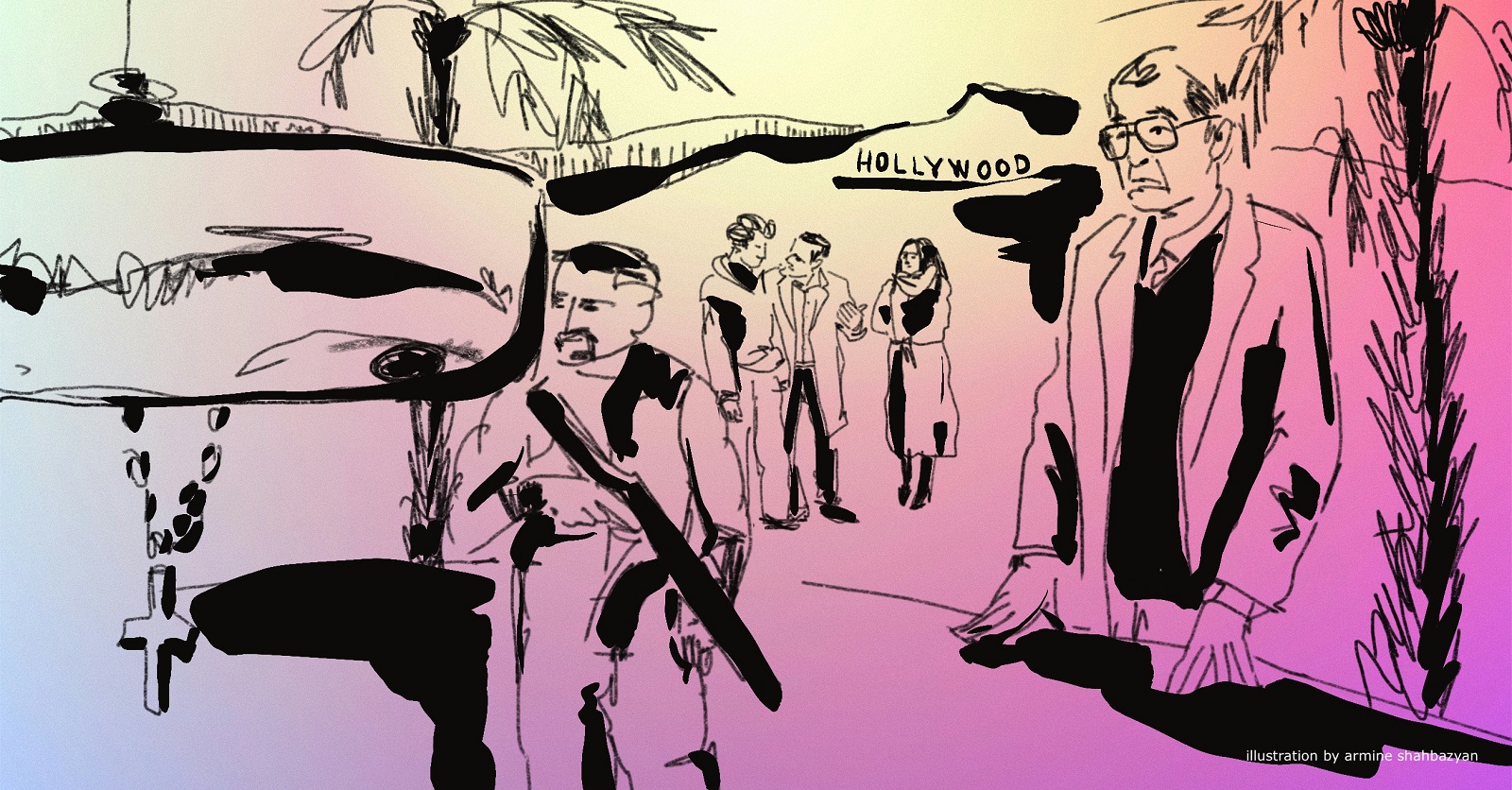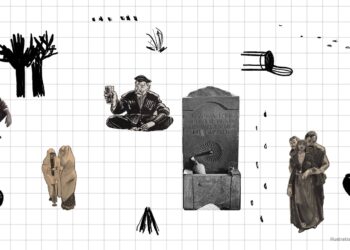
Listen to the article.
This year “Anora” (2024), directed by American director Sean Baker, won the top prize at the Cannes Film Festival. While the international film community focused on Baker’s portrayal of sex workers and his efforts to normalize their everyday lives, the film presented another point of interest for us: the Armenian storyline and characters played by Karren Karagulian and Vache Tovmasyan. In the film, they are portrayed as fiercely loyal employees of a Russian oligarch, tasked with finding the boss’s spoiled and faint-hearted son who has married Ani, a sex-worker (who is not Armenian).
In “Anora”, the Armenian characters are fairly authentic. Their behavior, attire, and vocabulary mirror those of the subculture’s representatives in Yerevan, Rostov, or Los Angeles––the very people Baker aims to dramatize. This isn’t Baker’s first attempt to depict Armenian characters, a credit largely due to Karren Karagulian, his friend and long-time collaborator. Karagulian features in nearly all of Baker’s films, including “Take Out” (2004), “Starlet” (2012), and “The Florida Project” (2017). In “Tangerine” (2015), Karagulian’s character, Razmik, plays one of the leading roles. These examples invite an exploration into how American cinema portrays Armenian characters and how these portrayals have evolved over time.
Armenian characters and stories first appeared in American cinema during the silent era. One of the more famous examples is “Auction of Souls” (1919) by Oscar Apfel, which retold stories of the Armenian Genocide based on the memories of Arshaluys (Aurora) Mardiganian. Although this film is now considered lost, several other films on the same topic were made during this period.
From the 1930s to the 1950s, Armenians largely disappeared from American screens, occasionally mentioned for exotic appeal. One instance is Rudolph Maté’s war drama, “The Deep Six” (1958), where Ross Bagdasarian takes his fellow soldiers to a bar to “pick up” girls—marking the first time Armenian is heard in an American film. A few years earlier, one of the more intriguing and substantial Armenian characters appeared in “Mr. Arkadin” (1955), directed by Orson Welles. Based on a BBC radio show centered on Mr. Arkadian, Welles himself portrays the extremely wealthy and mysterious protagonist with many skeletons in his closet. In different voice-overs, the character is presented as either Russian (Mr. Arkadin) or Armenian (Mr. Arkadian). In subsequent years, a dark past or involvement in the criminal world became one of the widespread narratives through which Armenian characters were presented in cinema.
Barry Levinson’s drama, “You Don’t Know Jack” (2010), perfectly fits this description. Based on true events, the film dramatizes the life of Jack Kevorkian, a pathologist from Oakland County, Michigan, who, in the 1990s, championed the rights of terminally ill or profoundly disabled people to end their lives. According to some accounts, he assisted in the deaths of around 130 people. The director adds depth to Kevorkian’s character by highlighting his background as a descendant of Genocide survivors.
The trauma of genocide is a stereotypical feature for Armenian characters appearing in multiple films. For example, Gene Quintano’s comedy, “Why Me?” (1990), revolves around the theft of a sacred ruby, the Byzantine Fire on loan from Turkey to the U.S. The thieves are Armenians, and the main characters of the film accidentally steal the ruby from this group. Besides the Armenian criminals, there’s also a deranged Armenian woman terrorist who acts in the name of the “Armenian liberation party.” She repeatedly talks about the danger her family will face if she does not perform certain actions––most often referring to blowing up buildings or cars.
The Armenian family as a context is also a reoccurring characteristic in films of American directors. In Alexander Payne’s “Sideways” (2004), the protagonist is marrying an Armenian woman whose family home appears at the beginning and end of the film. This family, living among Martiros Saryan paintings and artwork with gilded Armenian letters, symbolizes righteousness, morality and prosperity––qualities the character tries to escape but ultimately returns to.
Armenia and Armenian family life are also captured in Braden King’s “Here” (2011), which won a special mention at Berlinale. The film follows Will (Ben Foster), an American engineer visiting Armenia for a mapping survey in rural areas, who meets Gadarine (Lubna Azabel), an Armenian photographer. Beyond depicting their relationship, the director explores family ties: Gadarine, who left Armenia years ago and succeeded in her career, faces her parents’ conflicting feelings of criticism and pride, both expressed in silence. Since “Here” is in part a road movie, it includes encounters with other Armenian characters, all portrayed truthfully and without exaggeration. It’s one of the rare examples that explores the depth and sensuality of Armenian themes but unfortunately, so far it remains an exception in cinema.
Sean Baker’s “Tangerine” (2015) presents a far-from-stereotypical Armenian family. The film stars Razmik (Karren Karagulian), an Armenian taxi driver who regularly visits transgender sex workers. Soon, his wife and mother-in-law find out about his activities, and the colorful drama––shot entirely on iPhone––erupts with passionate Armenian screams and shouting. Karagulian masterfully portrays the patriarchal, “rough” Armenian man who believes that being tough on his family proves his masculinity. However, the plot twist forever dethrones him.
George A. Johnson’s “Pulled from Darkness” (also titled “Pursuit for Freedom”, 2022), presents an unusual and controversial father figure. In the film, the Armenian husband “loses” his wife in a gambling game to Ukrainian criminals. She is subsequently sold into sex slavery, after which the husband’s character disappears from the narrative. The film also features other Armenian characters, including the husband’s parents and relatives from Spitak who care for the couple’s orphaned children. Unfortunately, the film is poorly executed and unpleasant to watch. It attempts to address numerous social, political and religious topics but falls short in its execution.
In recent years, Armenian characters have appeared in episodic roles. For example, in John Patton Ford’s “Emily the Criminal” (2022), Emily attempts to steal a BMW from Armenian car dealers, who violently beat her up. In J. J. Perry’s “Day Shift” (2022), we meet the Nazaryan brothers, brave vampire hunters. Such characters appear more frequently in American series, particularly in crime fiction (e.g. “The Shield”, “Weeds”, “House of Cards”).
The portrayal of Armenian characters in American films in recent decades indicates a change in public perception. Initially depicted as mostly male figures with tragic or dark pasts, they are now relegated to episodic roles as criminals and thieves.In Woody Allen’s 1972 film “Everything You Always Wanted to Know About Sex (But Were Afraid to Ask)”, he introduces an Armenian shepherd romantically involved with his sheep. Curiously, Allen names him Milos—a Greek name—perhaps to avoid offending Armenians or mock everybody equally. However, in recent decades, the stereotypical and sometimes offensive portrayals of Armenians in these films border racism and poor taste.
Despite the significant Armenian presence in American cinema, the community has yet to develop a strategy or tools for meaningful representation on this influential platform. While the number of Armenian professionals in various fields of the American film industry continues to grow, this hasn’t led to a nuanced exploration of Armenian stories and characters. Instead, there is a limited range of stereotypes. When Armenian viewers encounter these portrayals, they often react with parochial pride rather than questioning why Armenians are depicted as petty criminals, “qyartu” taxi drivers, or spoiled businessmen by foreign directors. The impact of such portrayals may seem trivial, but given Hollywood’s significant influence in shaping global perceptions of nations and cultures, these demeaning depictions can have profound negative consequences. This is especially concerning today, when we need to draw the world’s attention to more urgent problems. It is time to view the crude representation of Armenians in international cinema and television not as a “big brother’s” affectionate gesture, but as a political issue that affects perceptions of Armenians, Armenia and our culture.
Film Review on
EVN Report
Salome of Our Days: From Misogyny to a Woman-Centric Narrative
Blending the two worlds of theater and cinema, Atom Egoyan’s new film “Seven Veils”—named for the biblical character Salome whose seductive dancing earns her the severed head of John the Baptist—portrays Salome not as a cruel femme fatale but as a victim.
Read moreFrom Artsakh to Gaza, No One Will Be Free
An Armenian film, “1489” won the Main Jury and the International Federation of Film Critics prizes at the International Documentary Film Festival of Amsterdam in 2023 amid upheaval and controversy that triggered a series of withdrawals and boycotts of the festival for its perceived silence regarding Israel’s invasion of Gaza.
Read moreTwo Films From One Fountain
The juxtaposition of two cinematic adaptations of the same literary work reveals polar perceptions of history, tradition, national culture and lifestyle. And by doing so, it indicates that the boundaries of "Armenian cinema" are much wider than they seem.
Read moreThe Armenian Dream: Michael Goorjian’s Film About Charlie the Repatriate
Michael Goorjian’s feature film “Amerikatsi” succeeded in infusing a sentimental and “positivist” tone inherent to Hollywood cinema within an Armenian reality, writes film critic Sona Karapoghosyan.
Read more





Well done, Sona. Not to add fuel to the fire, but the recent hit series on Netflix, Lincoln Lawyer, also depicts an Armenian mobster At least they got an Armenian to play the part, Michael Goorjian. You are correct that film should be a media that Armenians need to use to change the narrative about our people. This was eye opening.
Thank you for this excellent article, Sona. I am a US-based film scholar and historian (University of Vermont) with a particular interest in the representation of the Other in Soviet and post-Soviet cinemas. I’m interested in connecting with Armenian scholars and critics working on this issue in Armenian cinema, whether Soviet era or present-day. I realize this is a long shot request, but if you can offer a lead, I’d appreciate it.
Thank you for this in depth and factual analysis of the Armenian archetypal character from a Hollywood perspective. Let’s keep in mind that Hollywood is all about entertainment and of course the bottom line. Yes, it seems that the Armenian small time crook/gangster character sells in Hollywood, as it does in Armenia. After all, most if not all Armenian soap operas are about Armenian gangsters, too. Maybe, Armenian movie industry could start addressing its own stereotypes first, and Hollywood would follow.